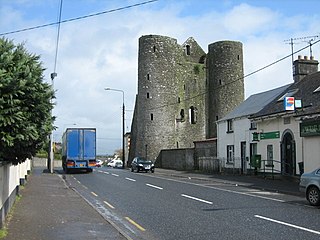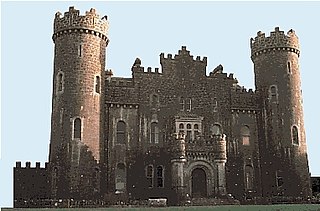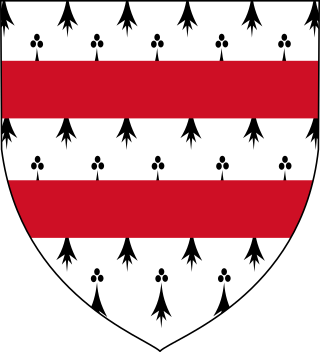
Baron Talbot of Malahide is a title that has been created twice for members of the same family—in 1831 in the Peerage of Ireland as Baron Talbot of Malahide, and in 1856 in the Peerage of the United Kingdom as Baron Talbot de Malahide. While the barony of 1856 became extinct in 1973, the barony of 1831 is extant. The ancestral seat of the family until 1976 was Malahide Castle, close to the village of that name, north of Dublin, Ireland.

Delvin is a village in County Westmeath, Ireland; it is located on the N52 road at a junction with the N51 to Navan. The town is 20 km (12 mi) from Mullingar.

Powderham Castle is a fortified manor house situated within the parish and former manor of Powderham, within the former hundred of Exminster, Devon, about 6 miles (9.7 km) south of the city of Exeter and 1⁄4 mile (0.4 km) north-east of the village of Kenton, where the main public entrance gates are located. It is a Grade I listed building. The park and gardens are Grade II* listed in the National Register of Historic Parks and Gardens.

Tullynally Castle, also known as Pakenham Hall, is a country house situated some 2 km from Castlepollard on the Coole village road in County Westmeath, Ireland. The Gothic-style building has over 120 rooms and has been home to the Pakenham family for over 350 years.

Stowe House is a grade I listed country house in Stowe, Buckinghamshire, England. It is the home of the private Stowe School and is owned by the Stowe House Preservation Trust. Over the years, it has been restored and maintained as one of the finest country houses in the UK. Stowe House is regularly open to the public.

Bramshill House, in Bramshill, northeast Hampshire, England, is one of the largest and most important Jacobean prodigy house mansions in England. It was built in the early 17th century by the 11th Baron Zouche of Harringworth but was partly destroyed by fire a few years later. The design shows the influence of the Italian Renaissance, which became popular in England during the late 16th century. The house was designated a Grade I listed building in 1952.

Luscombe Castle is a country house situated near the resort town of Dawlish, in the county of Devon in England. Upon purchasing the land at Luscombe in 1797, Charles Hoare demolished the existing house and commissioned architects John Nash and Humphrey Repton to design a new house and gardens at the site. Nash and Repton came up with an asymmetrical designed building made from Portland stone, with castellated parapets, turrets and pinnacles to create the feel of a picturesque castle.

Knockdrin is a townland and electoral division that is 5.6 kilometers northeast of Mullingar, in County Westmeath, Ireland. It is the home of the Westmeath Hunt, and its most notable building is Knockdrin Castle. The R394 regional road, the main Mullingar to Castlepollard route, runs through the area.

Clonyn Castle also known as Delvin Castle, is a Victorian country house situated in Delvin, County Westmeath, Ireland some 18 km from Mullingar along the N52. It is a square, symmetrical, two-storey castle-like building of cut limestone with four tall, round corner towers at each corner. The interior has a large two-storey hall with a gallery and arcading. It was one of the last Victorian baronial castles to be built in Ireland.

Sir Nugent Talbot Everard, 1st Baronet was an Irish senator nominated to the 1922 Seanad Éireann.

Killua Castle, and the nearby Raleigh Obelisk, are situated near Clonmellon, County Westmeath, Ireland. The present house was built in about 1780 by Sir Benjamin Chapman and consisted of a hall, dining room, oval drawing room, breakfast parlour and front and back stairs. There was also a stable yard, barn and haggard. From here, the Chapmans administered the surrounding farm lands of some 9,000 acres (36 km2) in the 18th century. In a ruinous condition, it was renovated in 2006.

Dardistown Castle is a castle and country house situated in parkland near Julianstown in County Meath, Ireland a few miles south of Drogheda.

Marchmont House lies on the east side of the village of Greenlaw, and near to a church in Polwarth in Berwickshire, in the Scottish Borders area of Scotland. It is about five miles south west of Duns, about 19 miles (31 km) west of Berwick-upon-Tweed and about 40 miles (64 km) south east of Edinburgh. Situated in a gently undulating landscape, the estate is intersected by Blackadder Water, and its tributary burns. With the Lammermuir Hills to the north and views towards the Cheviot Hills in the south, this part of Berwickshire, sometimes referred to as the Merse, is scenic and contains rich agricultural land.
The High Sheriff of Westmeath was the British Crown's judicial representative in County Westmeath, Ireland from its creation under The Counties of Meath and Westmeath Act 1543 until 1922, when the office was abolished in the new Free State and replaced by the office of Westmeath County Sheriff. The sheriff had judicial, electoral, ceremonial and administrative functions and executed High Court Writs. In 1908, an Order in Council made the Lord-Lieutenant the Sovereign's prime representative in a county and reduced the High Sheriff's precedence. However the sheriff retained his responsibilities for the preservation of law and order in the county. The usual procedure for appointing the sheriff from 1660 onwards was that three persons were nominated at the beginning of each year from the county and the Lord Lieutenant then appointed his choice as High Sheriff for the remainder of the year. Often the other nominees were appointed as under-sheriffs. Sometimes a sheriff did not fulfil his entire term through death or other event and another sheriff was then appointed for the remainder of the year. The dates given hereunder are the dates of appointment. The following is an incomplete list: all addresses are in County Westmeath unless stated otherwise.
The High Sheriff of Cavan was the British Crown's judicial representative in County Cavan, Ireland from the 16th century until 1922, when the office was abolished in the new Free State and replaced by the office of Cavan County Sheriff. The sheriff had judicial, electoral, ceremonial and administrative functions and executed High Court Writs. In 1908, an Order in Council made the Lord-Lieutenant the Sovereign's prime representative in a county and reduced the High Sheriff's precedence. However the sheriff retained his responsibilities for the preservation of law and order in the county. The usual procedure for appointing the sheriff from 1660 onwards was that three persons were nominated at the beginning of each year from the county and the Lord Lieutenant then appointed one of the nominees as his choice of High Sheriff for the remainder of the year. Often the other nominees were appointed as under-sheriffs. Sometimes a sheriff did not fulfil his entire term through death or other event and another sheriff was then appointed for the remainder of the year. The dates given hereunder are the dates of appointment. All addresses are in County Cavan unless stated otherwise.
The High Sheriff of Longford was the British Crown's judicial representative in County Longford, Ireland from the 16th century until 1922, when the office was abolished in the new Free State and replaced by the office of Longford County Sheriff. The sheriff had judicial, electoral, ceremonial and administrative functions and executed High Court Writs. In 1908, an Order in Council made the Lord-Lieutenant the Sovereign's prime representative in a county and reduced the High Sheriff's precedence. However the sheriff retained his responsibilities for the preservation of law and order in the county. The usual procedure for appointing the sheriff from 1660 onwards was that three persons were nominated at the beginning of each year from the county and the Lord Lieutenant then appointed his choice as High Sheriff for the remainder of the year. Often the other nominees were appointed as under-sheriffs. Sometimes a sheriff did not fulfil his entire term through death or other event and another sheriff was then appointed for the remainder of the year. The dates given hereunder are the dates of appointment. All addresses are in County Longford unless stated otherwise.

Rode Hall, a Georgian country house, is the seat of the Wilbraham family, members of the landed gentry in the parish of Odd Rode, Cheshire, England. The estate, with the original timber-framed manor house, was purchased by the Wilbrahams from the ancient Rode family in 1669. The medieval manor house was replaced between 1700 and 1708 by a brick-built seven-bay building; a second building, with five bays, was built in 1752; the two buildings being joined in 1800 to form the present Rode Hall.
Richard Nugent, 2nd Earl of Westmeath was an Irish nobleman.
Thomas Nugent, 4th Earl of Westmeath was an Irish soldier and peer. He was the second son of Christopher Nugent, Lord Delvin and Mary Butler, daughter of Colonel Richard Butler. He was likely the resident of Coolamber Hall House.

The O'Reilly, later Nugent baronetcy, of Ballinlough in the County of Westmeath, was created in the Baronetage of Ireland on 23 July 1795 for Hugh O'Reilly. In 1812, on the death of his maternal uncle John Nugent, he assumed by Royal licence the surname of Nugent. The third Baronet was Chamberlain to the Emperor of Austria and was also created a Count of the Austrian Empire. The family seat is Ballinlough Castle, Clonmellon, County Westmeath.















